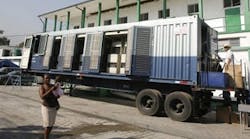On January 12 of this year, Haiti was struck by a devastating magnitude 7.0 earthquake that took more than 200,000 lives. In its wake, hundreds of thousands of its citizens were in need of water, food, and other relief, and time was critical. Thanks to the efforts of the U.S. Government and Aqua Sciences, Inc.'s air-to-water machine, many lives were saved.
The U.S. military's U.S. Southern Command was tasked with coordinating U.S. relief efforts for Haiti. One of the first priorities was fulfilling a request from Haiti's University Hospital for potable water technology. Bill Lawton from the U.S. Department of Commerce's U.S. Commercial Service found a solution from Aqua Sciences as the company had indicated its willingness to loan-out the "air-to-water" machine as a way of showcasing the innovative technology for ongoing disaster relief efforts. Moreover, documentation showed that Aqua Sciences' product had previously been purchased by FEMA in 2006. The product had received SECURE certification by the U.S. Department of Homeland Security-just a few weeks before the Haiti earthquake presented the opportunity to save lives in Port-au-Prince.
Working through U.S. Southern Command, Lawton arranged for the air shipment of the 20-ton, 40-ft. machine to Haiti's capitol of Port-au-Prince, where Aqua Sciences would provide operational and technical services and support. Within one week the donated machine was saving lives at University Hospital, the nation's largest hospital.
A Doctor Weighs-in: A Report From University Hospital in Port-au-Prince
At the hospital the air-to-water machine was gearing up producing some 1500 gallons a day, or enough water to be the primary source of water for all of the patients and medical staff at the University Hospital. The water was also used for wound cleansing and surgical scrubbing. Throughout the machine's two-month stay at the hospital, hundreds of lives were saved and patient comfort improved in the 700-bed medical facility.
"The Haiti disaster is a prime example of the importance of water during the emergency relief period. In the first days after the earthquake, the municipal water systems in Port-au-Prince were destroyed and there was little water available for the survivors. People and relief organizations struggled to get water from any source, no matter how dirty, for themselves and to provide it for others. Initially, any water may be useful, just to keep the body going, but unless clean water is supplied quickly outbreaks of diarrhea and other infectious diseases will spread rapidly."
Dr. Kirsch then described the efforts of Scott Morris, Aqua Sciences' executive tasked to Haiti, naming him the 'Water Dude,' who actually operated the machine:
"The (air-to-water) chemical process is far beyond my understanding-all I know is that it provided water, a lot of water that was critical for our patients, our work, and our survival. Scott is a lean guy in dark aviators and a battered, curled-brim straw cowboy hat, but was a bit of a mystery, always polite, but mostly quiet as he ceaselessly went about his work. He never seemed tired, or bothered by the relentless heat and sorrow. Every day Scott started at the control station at the end of the trailer turning dials and pushing buttons like some mysterious Wizard of Oz. He spent most of his day, 10-12 hours of it, carrying big shiny Mylar bags of pure water around the compound to the wards, the patients and the tents of various NGOs. His work probably saved more lives than anything I did as a physician. Water is the basis of life and the core of public health and the 'Water Dude' made it and delivered."
Moving Forward
Compared to older air-to-water technology, which can produce limited amounts of water in only very humid environments, Aqua Sciences' machines utilize a liquefied salt solution that removes large quantities of water in almost any environment. As a result, the company sees numerous opportunities to use this technology in solving drinking water-related issues around the globe.
Worldwide, the United Nations reports that between 5 and 9 million people die annually as a result of lack of access to safe drinking water. The latest water-from-air technology boasts many advantages over bottled water in terms of cost and logistics, especially when it comes to disaster relief. For example, bottled water, including shipping, can cost $15 or more per gallon as compared to water made out of air, which runs less than 50 cents per gallon, and has fewer logistical and supply-line demands.
Scott Morris of Aqua Sciences brings the bags of water to area hospitals.
Aqua Sciences plans to open manufacturing facility in the United States, and plans on adding U.S.-based "green" jobs while expanding its overseas sales with help from U.S. Commercial Service trade counseling, business matchmaking, market research, and other services.
Aqua Sciences is now working with NGOs in Haiti to help address the cholera outbreak as it looks to deploy its technology on a broader scale.
Curt Cultice is a senior communications specialist for the U.S. Commercial Service . With offices across the United States and in nearly 80 countries, the U.S. Commercial Service of the U.S. Department of Commerce's International Trade Administration utilizes its global network of trade professionals to connect U.S. businesses with international buyers worldwide. In 2009, the U.S. Commercial Service helped facilitate thousands of export successes worth billions of dollars in new sales for U.S. companies.



